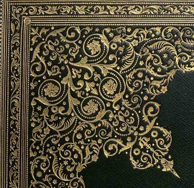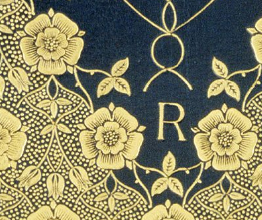Tomorrow I am going to see the Morgan Library’s exhibit Protecting the Word, which presents the collection’s most noteworthy bookbindings. To familiarize myself with the essential terminology of the bookbinding craft, I read up on the anatomy of the book and took a look at the British Library’s bookbinding brochure. Evidently, a binding’s main purpose is to protect the book’s text block, but since I do not intend to become a book binder any time soon, I skip the bit about sewing and glueing and dive straight into book decoration.
The Morgan exhibit has some magnificent medieval tomes on display, but frankly, medieval decorative binding deserves its own chapter. Suffice it to say that the medieval book was a treasure, and bound accordingly, as in this fine specimen from the Morgan, the Lindau Gospels from St. Gall in Switzerland from the late ninth century:

But bookbinding as a craft and art in its own right begins much later, namely in the 15th century, after the invention of the printing press. One of the “fathers” of modern decorative bookbinding was a Frenchman by the name of Jean Grolier. Grolier was not a bookbinder himself, but a book collector famous for commissioning the bindings that now carry his name. Grolier’s love for books as well as for sharing them with others have inspired book artists, collectors and readers for centuries. A prominent feature of Grolier bindings is the Latin inscription Io. Grolierii et Amicorvm — (property) of Jean Grolier and his friends. Grolier’s willingness to share his book with his friends is the stuff of legend, and the famous New York Grolier Club donned his name in honour of his friendships (he befriended, among others, book luminaries such as Erasmus and Aldus Manutius). Below is an example of a Grolier binding from the British library. You can see the inscription and the geometrical and arabesque patterns that are typical of a Grolier design.

Whoever wants to become well-versed in the art of the binding must be able to recognise names such as Padeloup, Cobden-Sanderson, or Zaehnsdorf — the names of master bookbinders, exquisite craftsmen and brilliant innovators who left an indelible stamp on their craft. Books fortunate enough to be clad in one of their bindings are keenly sought treasures these days.
The art of bookbinding knows a multitude of decorative styles and methods — mosaic, pointillé, romantic, neo classical, art nouveau, art deco — and a host of technical terms. The technique of gauffed edges, for instance, refers to imprinting indented patterns on the fore- and sige-edges of a book. An onlay produces a mosaic effect in leather by replacing strips of the original leather binding with leather of a different colour. And dentelle decorations consist “of a combination of elliptical scrolls of slightly shaded leafy character joined to clusters and horders of great richness”. Magnificent!

And that concludes my primer to bookbinding. More when I return from the Morgan. For readers interested to learn more on the subject, here a paraphernalia of online sources:
– Herb Weitz’s brief history of decorative bookbinding
– Roberts and Etherington’s dictionary of bookbinding terms (excellent)
– Comprehensive link list to book arts provided by the Canadian Bookbinders and Book Artists Guild







